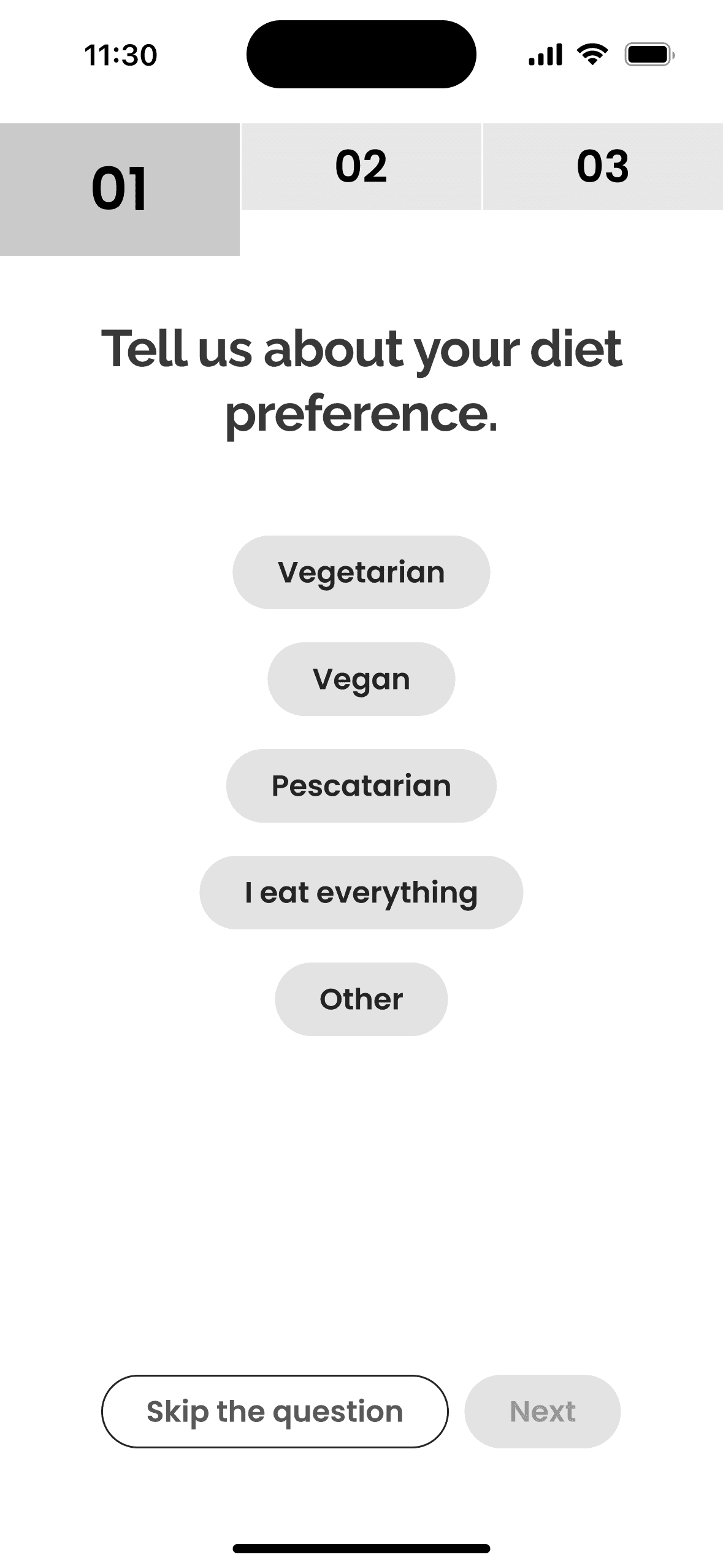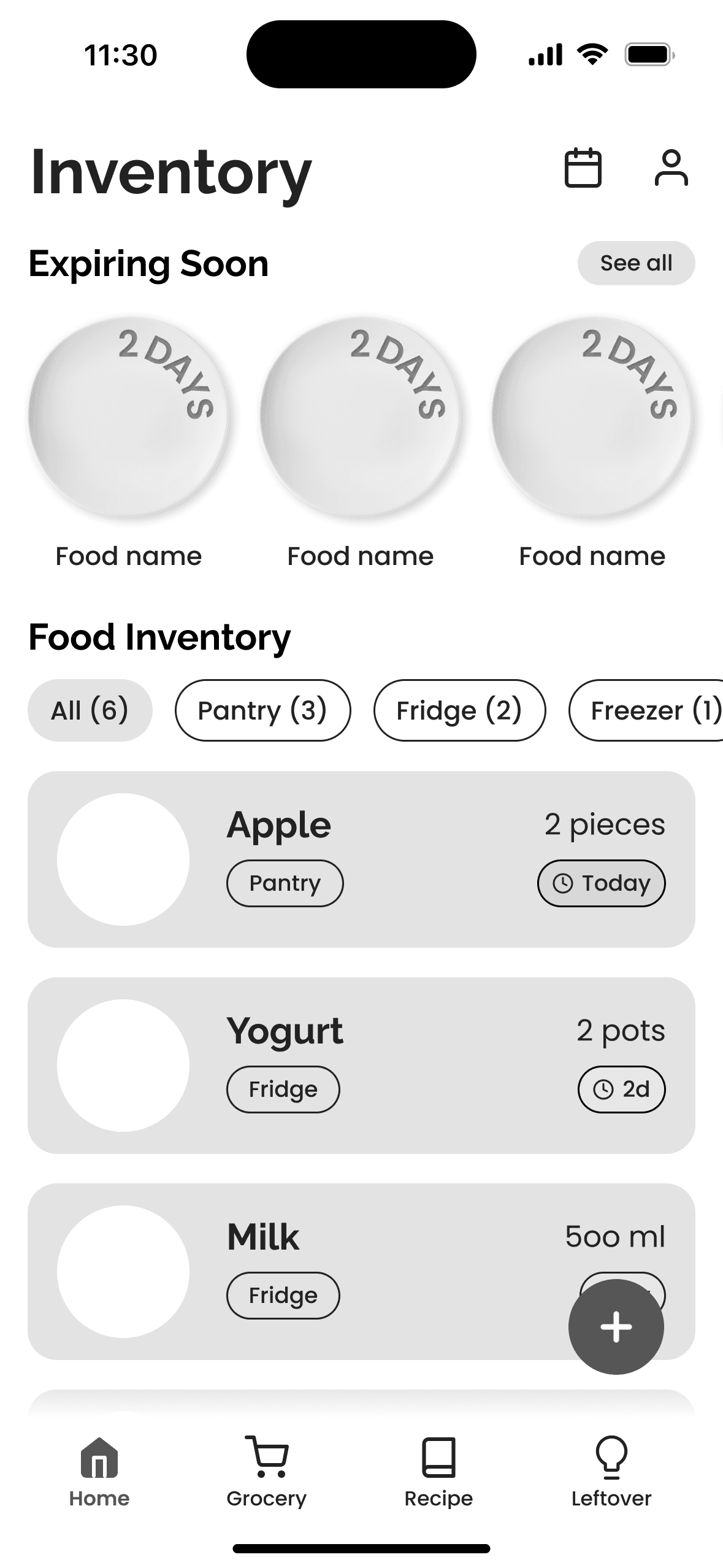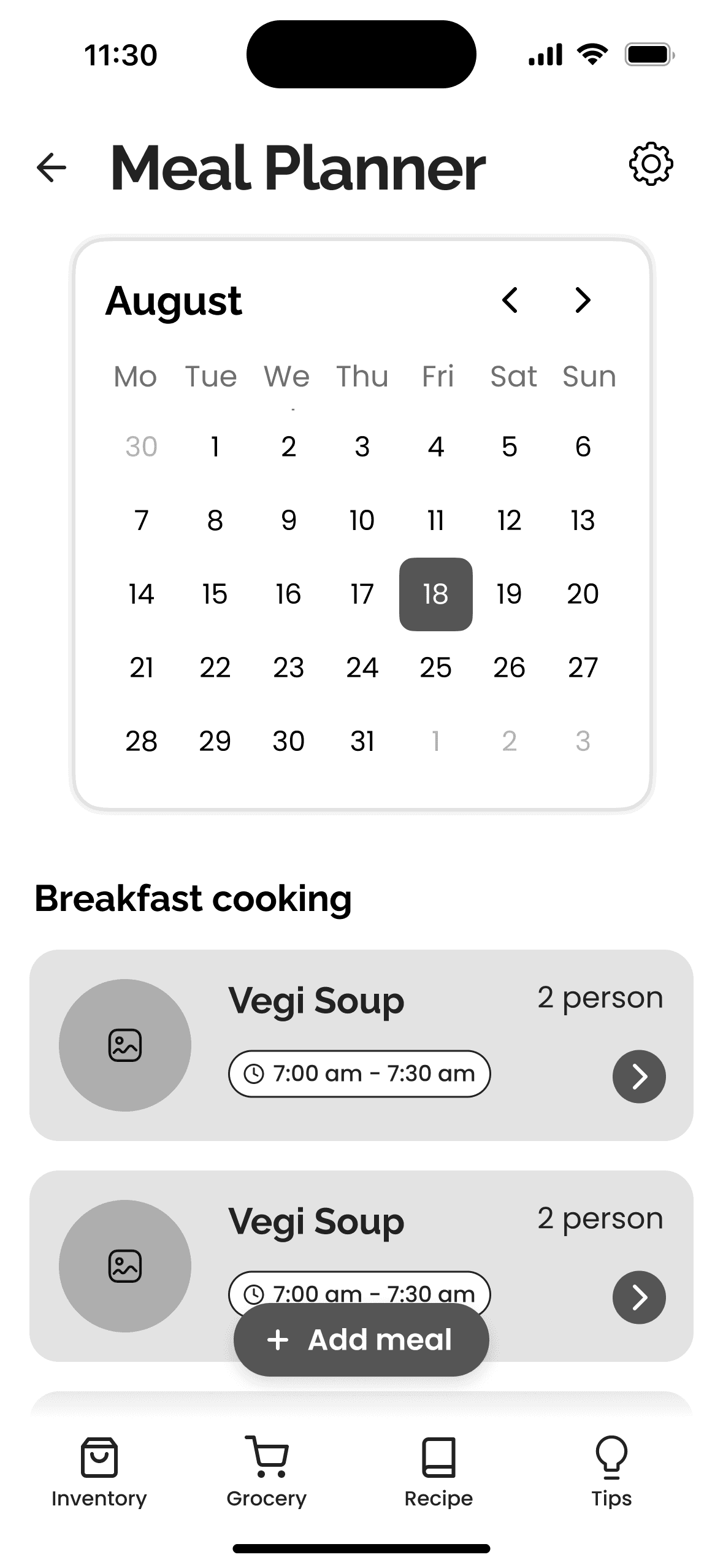
Hi there! 👋
WasteNot
YEAR
2024
SERVICES
UX
UI
RESEARCH
PRODUCT
TEAM OF
7
SUMMARY
As Lead and Designer on a team of 7, I spearheaded the creation of WasteNot, a mobile app concept designed to tackle the growing problem of household food waste. The app empowers users to track their food inventory, monitor expiration dates, and discover recipes based on what they already own.

01
SOLUTION
WasteNot
is designed to help individuals and households manage their food inventory. Not only that, it provides users with recipes based on what they already have and also educates and engages them in the fight against food waste.
02
SUCCESS METRICS
To guide our design,
as well as measure the potential success of WasteNot, we established three primary goals:
Reduce Food Waste
Enable users to decrease their self-reported weekly food waste by 25% after one month of consistent use.
Wiktor Wdowiak
High Engagement
Achieve a target of 70% of active users logging at least one inventory item and viewing one recipe per week.
Wiktor Wdowiak
Improve Meal Planning
Reduce the time users spend deciding "what's for dinner" by providing instant, inventory-based recipe suggestions.
Wiktor Wdowiak
03
CHALLENGE
Despite a growing awareness of food waste,
many households struggle with the practicalities. They lack an easy way to track food purchases, monitor expiration dates, and effectively use leftovers. This leads to overconsumption and a high volume of edible food being discarded, which has significant financial and environmental costs.
My Process in Brief
As Project Lead & UX/UI Designer, I guided our team through a comprehensive design process, from initial research (social media listening, food diaries, competitor analysis) and ideation (Crazy 8s, user flows) to creating and testing mid-fidelity wireframes that formed the foundation of our solution.
04
DECISIONS
My research and analysis led me to three critical design decisions that shaped the final product:
Make inventory tracking effortless
What I did
I co-designed a clean, visual inventory screen that allows users to see what they have at a glance, categorized by location (Fridge, Pantry). Crucially, it highlights items "Expiring Soon" to create a sense of urgency and prompt action.
Wiktor Wdowiak
Why it mattered
Our research showed the biggest hurdle was simply knowing what you have. A complicated system would be ignored. By making the inventory easy to scan and update, we removed the primary barrier to reducing waste.
Wiktor Wdowiak
Connect inventory to recipes
What I did
I designed a user flow that seamlessly connects the user's inventory to a recipe suggestion feature. Instead of an empty search bar, the app proactively suggests what users can make right now.
Wiktor Wdowiak
Why it mattered
This answers the user's next critical question: "What do I do with this food?" It closes the loop between knowing and acting, turning a list of ingredients into a tangible meal plan and preventing usable food from being wasted.
Wiktor Wdowiak
Onboard users by focusing on them
What I did
I co-designed the onboarding flow to focus on the user and ask them about their dietary preferences, ensuring that the app works in the exact way they would expect.
Wiktor Wdowiak
Why it mattered
This small step accomplishes two things immediately: it personalizes the future recipe suggestions, making the app instantly more valuable, and it frames the app around the user's lifestyle, not just as a sterile tracking tool. This increases the likelihood of long-term adoption.
Wiktor Wdowiak
05
LEARNINGS
From ‘Stop Waste’ to ‘Change Habits’
I quickly learned that our goal wasn't just to build a tool, but to design an experience that could subtly change user behavior. Features like expiration reminders and recipe suggestions aren't just functions; they are nudges designed to build a new habit of mindful consumption.
Leading a Team means focusing the Vision
As Project Lead on my first team project, I learned the importance of translating broad research insights into a clear, focused vision. My role was to constantly ask, "How does this decision help our user reduce waste?"
This kept our team of seven aligned and moving toward a common, well-defined goal.
06
RESULTS
Throughout the process,
regular team updates and feedback sessions were held to refine our designs. Our efforts culminated in
mid-fidelity wireframes that effectively address the initial problem statement!
Key user flows were polished and tested for usability.



Onboarding
Meal Planning
Inventory Screen

Hi there! 👋

Hi there! 👋
WasteNot
YEAR
2024
SERVICES
UX
UI
RESEARCH
PRODUCT
TEAM OF
7
SUMMARY
As Lead and Designer on a team of 7, I spearheaded the creation of WasteNot, a mobile app concept designed to tackle the growing problem of household food waste. The app empowers users to track their food inventory, monitor expiration dates, and discover recipes based on what they already own.


01
SOLUTION
WasteNot
is designed to help individuals and households manage their food inventory. Not only that, it provides users with recipes based on what they already have and also educates and engages them in the fight against food waste.
02
SUCCESS METRICS
To guide our design,
as well as measure the potential success of WasteNot, we established three primary goals:
Reduce Food Waste
Enable users to decrease their self-reported weekly food waste by 25% after one month of consistent use.
Wiktor Wdowiak
High Engagement
Achieve a target of 70% of active users logging at least one inventory item and viewing one recipe per week.
Wiktor Wdowiak
Improve Meal Planning
Reduce the time users spend deciding "what's for dinner" by providing instant, inventory-based recipe suggestions.
Wiktor Wdowiak
03
CHALLENGE
Despite a growing awareness of food waste,
many households struggle with the practicalities. They lack an easy way to track food purchases, monitor expiration dates, and effectively use leftovers. This leads to overconsumption and a high volume of edible food being discarded, which has significant financial and environmental costs.
My Process in Brief
As Project Lead & UX/UI Designer, I guided our team through a comprehensive design process, from initial research (social media listening, food diaries, competitor analysis) and ideation (Crazy 8s, user flows) to creating and testing mid-fidelity wireframes that formed the foundation of our solution.
04
DECISIONS
My research and analysis led me to three critical design decisions that shaped the final product:
Make inventory tracking effortless
What I did
I co-designed a clean, visual inventory screen that allows users to see what they have at a glance, categorized by location (Fridge, Pantry). Crucially, it highlights items "Expiring Soon" to create a sense of urgency and prompt action.
Wiktor Wdowiak
Why it mattered
Our research showed the biggest hurdle was simply knowing what you have. A complicated system would be ignored. By making the inventory easy to scan and update, we removed the primary barrier to reducing waste.
Wiktor Wdowiak
Connect inventory to recipes
What I did
I designed a user flow that seamlessly connects the user's inventory to a recipe suggestion feature. Instead of an empty search bar, the app proactively suggests what users can make right now.
Wiktor Wdowiak
Why it mattered
This answers the user's next critical question: "What do I do with this food?" It closes the loop between knowing and acting, turning a list of ingredients into a tangible meal plan and preventing usable food from being wasted.
Wiktor Wdowiak
Onboard users by focusing on them
What I did
I co-designed the onboarding flow to focus on the user and ask them about their dietary preferences, ensuring that the app works in the exact way they would expect.
Wiktor Wdowiak
Why it mattered
This small step accomplishes two things immediately: it personalizes the future recipe suggestions, making the app instantly more valuable, and it frames the app around the user's lifestyle, not just as a sterile tracking tool. This increases the likelihood of long-term adoption.
Wiktor Wdowiak
05
LEARNINGS
From ‘Stop Waste’ to ‘Change Habits’
I quickly learned that our goal wasn't just to build a tool, but to design an experience that could subtly change user behavior. Features like expiration reminders and recipe suggestions aren't just functions; they are nudges designed to build a new habit of mindful consumption.
Leading a Team means focusing the Vision
As Project Lead on my first team project, I learned the importance of translating broad research insights into a clear, focused vision. My role was to constantly ask, "How does this decision help our user reduce waste?". This kept our team of seven aligned and moving toward a common, well-defined goal.
06
RESULTS
Throughout the process,
regular team updates and feedback sessions were held to refine our designs. Our efforts culminated in
mid-fidelity wireframes that effectively address the initial problem statement!
Key user flows were polished and tested for usability.






Onboarding
Meal Planning
Inventory Screen
This portfolio
is not yet available
on mobile.
Please switch to
Desktop to view!
This portfolio
is not yet available
on mobile.
Please switch to
Desktop to view!

